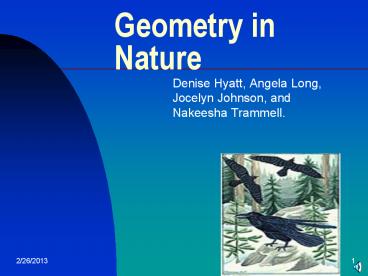Geometry in Nature - PowerPoint PPT Presentation
1 / 20
Title:
Geometry in Nature
Description:
Geometry in Nature Denise Hyatt, Angela Long, Jocelyn Johnson, and Nakeesha Trammell. Introduction Discovering the link between geometry and nature is not a difficult ... – PowerPoint PPT presentation
Number of Views:141
Avg rating:3.0/5.0
Title: Geometry in Nature
1
Geometry in Nature
- Denise Hyatt, Angela Long, Jocelyn Johnson, and
Nakeesha Trammell.
2
Introduction
- Discovering the link between geometry and nature
is not a difficult task. - Geometry is everywhere in the natural environment
- Geometry in Nature is also known as Fractal
Geometry developed by Benoit Mandelbrot.
3
Natures highest points in Geometry
- Fibonacci Numbers and Nature
- Solar System
- Reflectional symmetry
- Weather
- The Nazca Lines
4
Fibonacci and Nature
- Fibonacci numbers describes a series of numbers
in which successive numbers is equal to the sum
of the two proceeding numbers. - Examples range from animals, vegetables, and
flowers.
5
Fibonacci and Nature Cont
- The Echinacea purpura flower, also known as the
cone flower. - The orange petals follow Fibonaccis pattern by
the spirals curving left and right. - The numbers in each spiral follows the
neighboring pattern of Fibonaccis sequence.
6
Solar Geometry
- The distance from each planet from the sun can be
described by a unique geometric formula. - The orbital distance between each planet from the
sun is calculated by using various geometric
shapes, which include square sides, radius of a
circle, equilateral triangles, and isosceles
triangles. - Four examples are Mecury and Venus, Venus and
Earth, Earth and Mars, and Mars and Jupiter.
7
Solar Geometry Cont
- reflection of light
- Even though the discovery of the geometrical
basis for all natures designs were publised by
Fuller more than 30 years ago, todays society
still is not aware of this huge achievement. - Energy cannot stand still , it is always in
motion, so it is constantly moving in some
direction. - Since energy is traveling in a direction for a
specific amount of time, it is called a vector. - Anything with an inside and outside is called a
system, and the minimum system in the universe
has to be a tetrahedron.
8
Reflectional Symmetry
- Reflectional symmetry is shown in many areas of
nature - These include moths, the human body, and fruit.
9
Weather
- As snow crystals form, they become a hexagonal
shape, it seems like an infinite number of
variations for being six-sided. - The temperature that the crystals forms, and to
less extent the humidity of the air, determine
the basic shape. - Snow crystals form a hexagonal shape because of
the way the two hydrogen atoms join with an
oxygen atom to form a water molecule.
10
The Nazca Lines
11
The Nazca Line
- Discovered in 1930
- Scattered over 500 square km
- Contains over 50 geoglyphs
- Over 1,300 km straight lines
- 300 geometric shapes
12
Geoglyphs
- These geometrical forms include straight lines,
triangles, spirals, circles,trapezoid and
depiction of animals and plants
13
How Are They Formed?
- Pampas
- Desert with little wind covered with black
wind-smoothed rock
- Lines were created by removing the black
fragments and topsoil
14
The Nazca Lines
- The Nazca lines can be as narrow as 6 inches and
as wide as hundreds of yards.
15
Thunderbird
- One of the most famous geoglyphs
- Lines are formed by one continuous line
16
Intersecting Lines
- These two Nazca Lines are intersecting because
they share a common point.
17
Trapezoid
- Wedge-like
- This trapezoid has sides that are 2,500 ft long
- Its sides run parallel for about 5 miles
18
Theories of the nazca Lines
- Space craft landing
- Population control systems
- Running footraces
- Astronomical purposes
19
Fractal Geometry
- Developed by Benoit Mandelbrots study of
complexity and chaos.
20
Modern Uses
- Landscaping
- Intricate models
- Images of natural scenes
- Mountain ranges and coast lines































